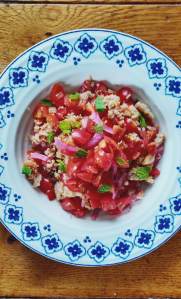

Panzanella
On a hot, summer day in Lucca, few places are more agreeable to have lunch at than under the stone arches of the old trattoria Da Giulio, well protected from the gaze of the sun. The menu never changes (dreary to be a chef there, one would have thought) and the food is solid rather than exceptional, but the combination of decent food, smiling service, reasonable prices and perfect location, makes this place dear to its many customers. I generally stick to the usual summer suspects: either pappa al pomodoro or panzanella, both stalwarts of Tuscan cookery. The former is a a thick bread and tomato soup served at room temperature; the latter a salad of crumbled stale bread, tomatoes and red onions.
I have just googled “panzanella” and I got about 9,060,000 results. No one can doubt that this summer dish has made it big on the food world stage, with versions ranging from the monastic to the sybarite.
Panzanella comes from the regions of central Italy: Toscana, Lazio, Umbria, Marche and Abruzzo, but the Tuscan one is perhaps the most famous. At its most basic, it is a mix of old, dry bread, soaked, squeezed and crumbled, tomatoes, red onions and basil, dressed with oil and vinegar and eaten slightly chilled. But variations abound: cucumbers, olives, capers, snippets of anchovies, sliced boiled eggs, all can go in a panzanella. I have seen versions where the stale bread is briefly soaked and then squeezed and coarsely cut up (instead of being crumbled) and others where fresh bread is being used, toasted, rubbed with garlic and then cut into neat cubes or torn into rough pieces. You get it: one basic idea, endless interpretations.
This is my version, pretty close to the one I often eat in Lucca’s trattorias, with some personal tweaks. Quantities are unimportant, but I prefer a salad heavy on the vegetables and lighter on bread.
Roughly speaking, for 1 large portion or 2 small portions, I generally use:
60g dry bread
200g tomatoes (net weight)
half a red onion, possibly a sweet Tropea onion
oil, vinegar to taste.
Basil or mint
Capers, slivered green olives, cucumbers, depending on the mood.
The bread. It must be from a loaf with a rather chewy crumb. In my experience, a sourdough loaf works best (as opposed to a bakery yeast loaf). It must be not just stale, but stone dry, in order to withstand the soaking without becoming a pap. Cut up your bread in big hunks and immerse them in cold water. As soon as you can feel they are softening (seconds, rather than minutes), lift them out. Some parts will be softer than others (the crust always stays a little harder) and that’s fine. Squeeze them in between your palms, removing as much liquid as possible.
Crumble them into irregular crumbs or pieces into a bowl. This mix should feel on the dry, crumbly side. Dress them with a little salt, oil and a dash of vinegar. It is crucial the bread is not soggy.
The tomatoes. Use good, ripe tomatoes. I dice them small, using pips, juices and all. Dress them with a little oil and salt.
The onions. I always use red onions in salads, possibly of the sweet Tropea variety (and I never use them in ordinary cooking actually – one of my fixations). Slice them thinly, put them in a jar and cover with half wine vinegar (white or red) and half water, adding a generous pinch of sugar and a fresh bay leaf, if you have it. Leave them to marinate for at least an hour. Especially in summers, I tend to have a tupperware of these marinated red onions constantly in my fridge, because I use them a lot in salads. If you do not care much for the vinegary taste, just soak the onions in cold water for about one hour.
To assemble the salad, add the tomatoes (keeping some back to add on top of the salad) and the onions to the bread. Mix everything together using your hands and check for salt and vinegar: panzanella should be pleasantly, refreshingly vinegary. Refrigerate until slightly chilled. Add plenty of basil, mix lightly, drizzle with of oil before serving, scattering the leftover tomatoes on top.
I sometimes like to add a few capers, for their briny punch, and occasionally some sliced cucumbers (the slices having been salted first for about thirty minutes, drained and dried on a cloth, dressed with a little vinegar). Instead of basil, I also use mint. Occasionally I use slivered green olives, omitting the capers.





